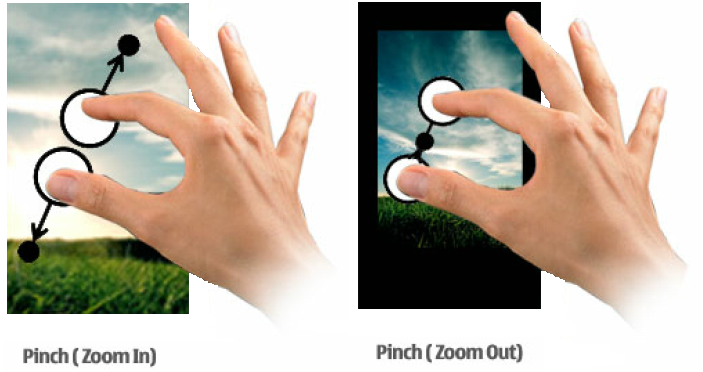Multiple touch
Multiple touch is an enhancement to the touch screen, which provides the user with the ability to apply elaborate finger gestures onto the display as commands to the device.
Multiple touch is implemented based on the size and type of interfaces. When a finger or an object touches the display causing the light to scatter, the reflection is caught by the sensors. The response for the touch is sent back based on the type of reflection measured.
Only the devices with multiple touch support have 'Pinch Stroke' as a touch stroke.
Pinch Stroke
Pinch stroke is invoked by two separate but simultaneously active touch down events and dragging movements along the line that goes through both touch down points. On release, the pinch in or pinch out state is maintained. Pinch stroke can be utilized, for example, in Photo viewer to zoom in and zoom out.The following table lists the default touch-events for pinch-stroke:
|
User action |
State change |
Feedback |
|---|---|---|
|
First touch down |
No action. |
Tactile:
|
|
Second simultaneous touch down |
Activates multiple touch mode for the content defined. |
Tactile:
|
|
Pinch in |
Moving the touch points (directly) closer to each other is recognized as pinch in. Application can use it, for example, for zooming out a picture. The behavior should be in relation to the speed and size of the stroke. |
Tactile: Smooth pinch effect is provided while moving the fingers. No audio feedback is provided. |
|
Pinch out |
Moving the touch points (directly) away from each other is recognized as pinch out. Application can use it, for example, for zooming in a picture. The behavior should be in relation to the speed and size of the stroke. |
Tactile: Smooth pinch effect is provided while moving the fingers. No audio feedback is provided. |
|
Touch release |
Releasing one or both fingers stops the pinch. |
No tactile or audio feedback given. |
Using multiple touch in applications
For multiple touch, use classes TRawEvent and TAdvancedPointerEvent (which extends TPointerEvent ). For more information, see Advanced pointers section.Copyright ©2010 Nokia Corporation and/or its subsidiary(-ies).
All rights
reserved. Unless otherwise stated, these materials are provided under the terms of the Eclipse Public License
v1.0.
